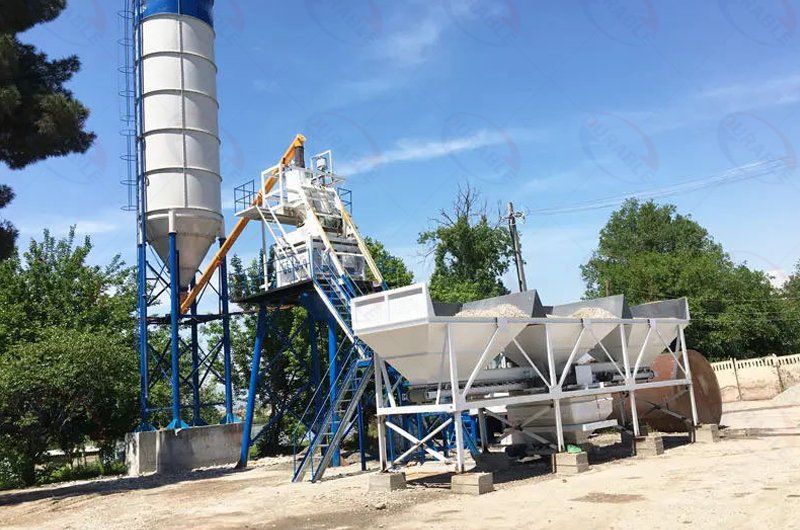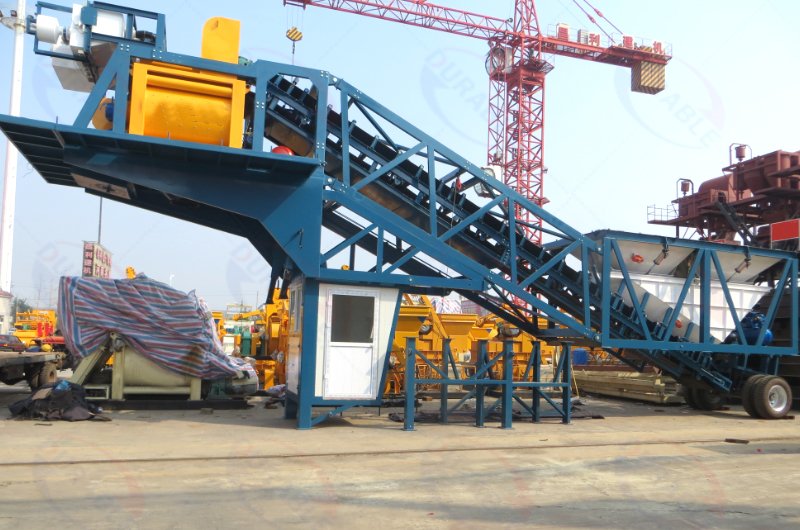Wet Concrete Batching Plant: A Complete Guide [2025]
A wet concrete batching plant, also known as a central mix plant, is a facility that acts like a central kitchen for making concrete. It is where we mix all the ingredients—sand, stone, cement, water, and any special additives—together in a large, powerful mixer at the plant itself. This process creates perfectly uniform, high-quality concrete before it is ever loaded into a truck. This is very different from a dry batch plant, where the truck itself does the mixing on the way to the job site.

What is the core of a wet batch plant?
The heart and soul of every wet batch plant is its large, stationary mixer. This is not the simple spinning drum you see on a concrete truck. It is a piece of heavy industrial machinery designed for one job: creating the most consistent concrete possible.
The most common and effective type is the . This machine uses two horizontal shafts with powerful paddles. These paddles churn, fold, and shear all the materials together. This intense action forces every grain of sand and piece of stone to be coated with cement paste. It ensures all additives are perfectly blended. This compulsory mixing process creates a level of quality and uniformity that a simple truck mixer can never achieve. It is this central mixer that defines a wet batch plant and gives it a major advantage.
How does a central mix plant work?
The process at a wet concrete batching plant is a precise and efficient sequence. I have managed the setup of many of these plants, and their operation is an impressive display of engineering. Here is how it works from start to finish.
1. Storing and Moving Materials
First, sand and different sizes of stone, called aggregates, are stored in large hoppers or bins. From these bins, a long conveyor belt or a skip hoist carries the exact amount of aggregates needed for a batch up to a weighing hopper. At the same time, cement is stored in tall, separate bolted silos.
2. Weighing Everything Perfectly
This step is critical for quality. In separate, highly accurate weighing hoppers, the system measures the exact weight of the aggregates. It also weighs the precise amount of cement from the silo and water. Any liquid chemical admixtures, like those that help concrete flow better or set slower, are also measured with extreme precision. This is called dosing.
3. The Central Mixing Process
Once everything is weighed, all the ingredients are discharged into the central mixer. The machine then runs for a very specific, pre-programmed time. This is often as short as 30 to 60 seconds. In that brief period, the powerful mixing action creates a perfectly uniform, high-quality batch of fresh concrete.
4. Discharging into the Truck
After the mixing is complete, a large gate at the bottom of the mixer opens. The fresh, ready-to-use concrete is discharged directly into a transit mixer truck waiting below. The truck’s drum then turns very slowly on the way to the job site. It is only agitating the concrete to keep it from separating, not doing the main mixing work.
Why should you invest in a wet plant?
When a major construction company or ready-mix supplier chooses to spend the extra money on a stationary concrete batching plant, they are buying several key advantages. These benefits directly impact project quality, speed, and long-term profitability.
Superior Concrete Quality
This is the number one reason to choose a wet plant. The powerful, compulsory mixing action ensures every single batch is virtually identical to the last. Water is distributed perfectly. Cement coats every particle of aggregate. Admixtures are fully integrated. This creates stronger, more durable, and more reliable concrete. You simply cannot get this level of consistency from a truck mixer. For projects with strict quality specifications, a wet plant is essential.
Higher Production Speed
It may seem like an extra step, but a wet plant is much faster. Because the mixing is done in a dedicated, high-speed mixer, the truck cycle time is incredibly short. A truck pulls under the mixer, receives a full load of pre-mixed concrete in less than a minute, and then immediately leaves for the job site. This allows you to dispatch a continuous stream of trucks for massive pours, keeping large projects on schedule.
Reduced Wear on Your Trucks
Mixing dry, abrasive aggregates, cement, and water is extremely hard on the mixing fins and the inside of a truck’s drum. It causes a lot of wear and tear. With a wet batch plant, the truck is just a transportation vessel. This dramatically extends the life of your expensive truck fleet. It also means lower maintenance costs and less downtime for your vehicles over the long run.
Are there any downsides to a wet plant?
A wet batch plant is a superior technology, but it’s not the right solution for every single situation. You need to consider a few factors before making such a large investment.
| Factor | Challenge | How to Manage It |
|---|---|---|
| Initial Investment | A wet plant is more complex due to the large mixer and its support structure. This means the upfront capital cost is higher than a dry batch plant. | View it as a long-term investment in quality and efficiency that leads to lower operational costs and the ability to bid on higher-spec projects. |
| Larger Footprint | These plants typically require more ground space to accommodate the mixer, conveyor systems, and larger aggregate storage areas. | Proper site planning is essential. The layout must be optimized for truck flow and material storage before construction begins. |
| Workability Time | Since the concrete is fully mixed at the plant, the “clock starts ticking” on its workability (slump) immediately. | For very long travel times to a job site, you can use special chemical admixtures called retarders to slow down the setting process. |
What projects need a wet batch plant?
In my experience, I always recommend wet batch plants for clients whose projects demand the highest standards of quality, consistency, and performance.



- Major Infrastructure Projects: Think about dams, airports, bridges, and major highways. For these critical structures, the concrete quality specifications are non-negotiable. The consistency of a wet plant is the only way to guarantee these standards are met.
- Precast Concrete Yards: These facilities produce high-quality structural elements like beams, wall panels, and pipes. They need every single batch of concrete to be identical to ensure their final products have uniform strength and appearance.
- Large Commercial Ready-Mix Operations: In busy cities, ready-mix suppliers compete on quality and speed. They supply concrete for high-rise buildings and other large-scale construction where a fast, continuous supply of high-spec concrete is required.
Frequently Asked Questions
1. What is the main difference between a wet and a dry batch plant?
The main difference is where the concrete is mixed. A wet plant thoroughly mixes all ingredients in a powerful, stationary central mixer before loading the truck. A dry plant just weighs the dry ingredients into the truck, and the truck driver adds water and does the mixing.
2. How long does it take to mix concrete in a central mixer?
It is incredibly fast. A typical mixing cycle in a high-performance twin-shaft mixer takes only 30 to 60 seconds to produce a completely uniform batch of high-quality concrete.
3. Is a wet batch plant more profitable?
It can be much more profitable for the right business model. While the initial cost is higher, it leads to lower long-term truck maintenance costs. More importantly, it allows you to produce higher-quality concrete, which lets you bid on more demanding and lucrative projects.
Summary and Final Recommendation
A wet concrete batching plant is a serious investment in your company’s capabilities. It is the professional choice for businesses that want to prioritize quality, speed, and consistency. By using a central mixer, you remove variables from the process and gain total control over your final product. For any large-scale infrastructure, precast manufacturing, or competitive ready-mix operation, a wet plant is not just an option; it is the foundation for success.
About Durable
Since our founding in 2001, Durable Machine has been a professional manufacturer of construction and mineral processing equipment. We operate on a factory-direct B2B model, providing high-quality machinery to clients in over 120 countries. Our facilities are fully equipped to ensure excellent quality control at every stage, guaranteeing your complete satisfaction with our robust and reliable equipment.
If you are ready to invest in quality and efficiency, contact our expert team today. We can help you configure the perfect wet concrete batching plant to meet your specific project needs.
 Durable Machinery
Durable Machinery
